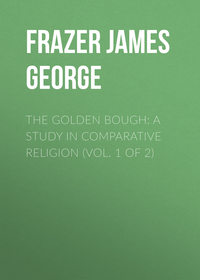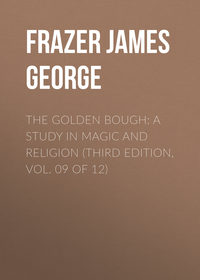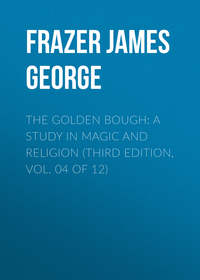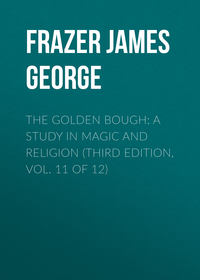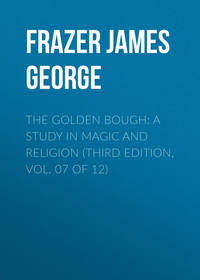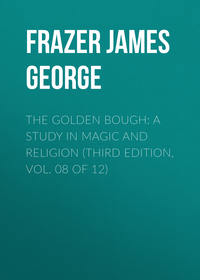
The Belief in Immortality and the Worship of the Dead, Volume 2 (of 3)
535
G. Turner, Samoa, pp. 257 sq.; S. Ella, op. cit. pp. 643 sq.; G. Brown, Melanesians and Polynesians, p. 221.
536
J. B. Stair, Old Samoa, p. 219.
537
G. Turner, Samoa, p. 257; S. Ella, op. cit. p. 643.
538
G. Turner, Samoa, pp. 258 sq.; G. Brown, Melanesians and Polynesians, p. 222.
539
J. B. Stair, Old Samoa, pp. 217 sq.; G. Brown, Melanesians and Polynesians, p. 221. On the question whether the Samoans held a doctrine of moral retribution after death, Dr. Brown observes: "I do not remember any statement to the effect that the conduct of a man in this life affected his state after death. They certainly believe this now, but whether they did so prior to the introduction of Christianity I cannot definitely say. I am inclined, however, to believe that they did not believe that conduct in this life affected them in the future" (Melanesians and Polynesians, pp. 261 sq.). Elsewhere, however, Dr. Brown seems to express a contrary opinion. He says: "It was generally understood that the conditions of men in this life, even amongst the common people, had an effect on their future conditions. A good man in Samoa generally meant a liberal man, one who was generous and hospitable; whilst a bad man was one who was mean, selfish, and greedy about food" (op. cit. p. 222).
540
G. Turner, Samoa, pp. 259 sq.; S. Ella, op. cit. p. 644.
541
G. Turner, Samoa, p. 259; S. Ella, op. cit. p. 644; G. Brown, Melanesians and Polynesians, pp. 219, 221, 222.
542
G. Turner, Samoa, p. 151.
543
G. Brown, Melanesians and Polynesians, pp. 245, 282.
544
G. Brown, Melanesians and Polynesians, p. 221, "They had no belief in the transmigration of souls either into animals, inert bodies, or into different human bodies."
545
W. H. R. Rivers, The History of Melanesian Society, ii. 358 sqq.
546
See above, pp. 92 sqq.
547
F. H. H. Guillemard, Australasia, ii. (London, 1894) p. 509.
548
W. W. Gill, Life in the Southern Isles (London, N.D.), p. 11. Compare John Williams, Narrative of Missionary Enterprises in the South Sea Islands (London, 1838), pp. 16, 174-176. According to Dr. Guillemard (loc. cit.), the height of Rarotonga is 2900 feet; according to W. W. Gill, our principal authority on the island, it is 4500 feet.
549
W. W. Gill, Life in the Southern Isles. pp. 7 sq.; id., From Darkness to Light in Polynesia (London, 1894), pp. 6 sq.; A. Baessler, Neue Südsee-Bilder (Berlin, 1900), pp. 271 sqq., 274 sqq. (as to the caverns).
550
F. H. H. Guillemard, Australasia, ii. 509. Compare A. Baessler, Neue Südsee-Bilder, pp. 257 sq., 269. The latter writer remarks on the great variety of types among the natives of these islands. In Mangaia he found the people darker than in Rarotonga, undersized, sturdy, with thick lips, noses broad and sunken at the bridge, which gave them a somewhat wild appearance. As to the tradition of an emigration of the Hervey Islanders from Samoa, see W. W. Gill, Life in the Southern Isles, pp. 23 sqq. "The Mangaians themselves trace their origin to Avaiki, or nether world; but Avaiki, Hawai'i, and Savai'i, are but slightly different forms of one word. The s of the Samoan dialect is invariably dropped in the Hervey Group dialects, whilst a k is substituted for the break at the end. No native of these days doubts that by Avaiki his ancestors really intended Savai'i, the largest island of the Samoan Group. In Polynesia, to sail west is to go down; to sail east is to go up. To sail from Samoa to Mangaia would be 'to come up,' or, to translate their vernacular closely, 'to climb up.' In their songs and myths are many references to 'the hosts of Ukupolu,' undoubtedly the Upolu of Samoa" (W. W. Gill, op. cit. p. 25). Compare id., Myths and Songs from the South Pacific (London, 1876), pp. 166 sq.
551
W. W. Gill, Life in the Southern Isles, pp. 13 sq.; id., "Mangaia (Hervey Islands)," Report of the Second Meeting of the Australasian Association for the Advancement of Science held at Melbourne, 1890, p. 324. As to the date of the introduction of Christianity into the Hervey Islands, see John Williams, Narrative of Missionary Enterprises in the South Sea Islands, pp. 491 sq.
552
John Williams, op. cit. pp. 175 sq.
553
W. W. Gill, Life in the Southern Isles, pp. 12, 15; id., "Mangaia (Hervey Islands)," Report of the Second Meeting of the Australasian Association for the Advancement of Science held at Melbourne, 1890, p. 336.
554
W. W. Gill, "Mangaia (Hervey Islands)," op. cit. pp. 332 sq., 338.
555
W. W. Gill, Life in the Southern Isles, p. 16; id., "Mangaia (Hervey Islands)," op. cit. pp. 335 sq.
556
W. W. Gill, Life in the Southern Isles, p. 16.
557
W. W. Gill, "Mangaia (Hervey Islands)," op. cit. pp. 323, 330, 331, 333.
558
W. W. Gill, "Mangaia (Hervey Islands)," op. cit. pp. 327-329. In the operation the prepuce was slit longitudinally, and the divided pieces were drawn underneath and twisted, so as in time to form a small knot under the urethra. As to the ceremony of assigning a child either to its father's or to its mother's tribe, see W. W. Gill, Myths and Songs from the South Pacific (London, 1876), pp. 36 sq.
559
W. W. Gill, "Mangaia (Hervey Islands)," op. cit. p. 326.
560
John Williams, Narrative of Missionary Enterprises in the South Sea Islands, pp. 183 sq.
561
W. W. Gill, "Mangaia (Hervey Islands)," op. cit. p. 335.
562
W. W. Gill, Myths and Songs from the South Pacific, p. 293.
563
See above, pp. 62 sq.
564
In the Hervey Islands a marae seems to have been a sacred grove. So it is described by W. W. Gill (Myths and Songs from the South Pacific, p. 14), who adds in a note: "These maraes were planted with callophylla inophylla, etc., etc., which, untouched by the hand of man from generation to generation, threw a sacred gloom over the mysteries of idol-worship. The trees were accounted sacred, not for their own sake, but on account of the place where they grew."
565
W. W. Gill, From Darkness to Light in Polynesia, pp. 314 sq. As to the installation of the priestly king by the temporal lord, see also id., "Mangaia (Hervey Islands)," op. cit. pp. 339 sq.
566
W. W. Gill, Myths and Songs from the South Pacific, pp. 3 sqq.; id., "Mangaia (Hervey Islands)," op. cit. pp. 348 sq. As to Rongo and Tangaroa, see E. Tregear, Maori-Polynesian Comparative Dictionary (Wellington, N.Z., 1891), pp. 424 sq., 463 sq., svv. "Rongo" and "Tangaroa."
567
W. W. Gill, Myths and Songs from the South Pacific, pp. 51-58.
568
W. W. Gill, Myths and Songs from the South Pacific, p. 58-60.
569
W. W. Gill, Myths and Songs from the South Pacific, pp. 61-63.
570
See above, pp. 182 sqq., 200 sqq.
571
W. W. Gill, Myths and Songs from the South Pacific, pp. 10 sq. 19. Another god called Turanga, who was worshipped at Aumoana, was also supposed to be incarnate in white and black spotted lizards. See id., Life in the Southern Isles, p. 96.
572
W. W. Gill, Myths and Songs from the South Pacific, pp. 29 sq.
573
W. W. Gill, Myths and Songs from the South Pacific, pp. 79 sq.
574
W. W. Gill, "Mangaia (Hervey Islands)," op. cit. p. 349.
575
W. W. Gill, "Mangaia (Hervey Islands)," op. cit. p. 347. Yet in the same passage the writer affirms that "there is no trace in the Eastern Pacific of the doctrine of transmigration of human souls, although the spirits of the dead are fabled to have assumed, temporarily, and for a specific purpose, the form of an insect, bird, fish, or cloud."
576
Id., Life in the Southern Isles, p. 289.
577
Id., Life in the Southern Isles, pp. 96, 308, 309.
578
Id., Life in the Southern Isles, p. 96.
579
Id., Myths and Songs from the South Pacific, pp. 34 sq.
580
Id., Myths and Songs from the South Pacific, p. 32.
581
Id., Life in the Southern Isles, p. 96.
582
Id., Myths and Songs from the South Pacific, p. 35; id., "Mangaia (Hervey Islands)," op. cit. p. 349.
583
W. W. Gill, Myths and Songs from the South Pacific, p. 35; id., "Mangaia (Hervey Islands)," op. cit. p. 349.
584
W. W. Gill, "Mangaia (Hervey Islands)," op. cit. p. 342. Compare id., Myths and Songs from the South Pacific, p. 35.
585
W. W. Gill, Myths and Songs from the South Pacific, p. 35; id., "Mangaia (Hervey Islands)," op. cit. p. 339; id., Life in the Southern Isles, p. 70.
586
W. W. Gill, "Mangaia (Hervey Islands)," op. cit. p. 347.
587
W. W. Gill, Myths and Songs from the South Pacific, p. 177.
588
W. W. Gill, Life in the Southern Isles, pp. 180-183; id., Myths and Songs from the South Pacific, p. 171.
589
W. W. Gill, Myths and Songs from the South Pacific, p. 181; id., "Mangaia (Hervey Islands)," op. cit. p. 344.
590
The name of the god of the Rarotongan paradise.
591
John Williams, Narrative of Missionary Enterprises in the South Sea Islands, pp. 477 sq.
592
W. W. Gill, Myths and Songs from the South Pacific, pp. 170 sq.
593
W. W. Gill, Life in the Southern Isles, pp. 72-76; id., "Mangaia (Hervey Islands)," op. cit. p. 343.
594
W. W. Gill, Life in the Southern Isles, pp. 78 sq.; id., "Mangaia (Hervey Islands)," op. cit. p. 344.
595
See The Golden Bough, Part II., Taboo and the Perils of the Soul, pp. 356 sqq.
596
W. W. Gill, Myths and Songs from the South Pacific, p. 187; id., "Mangaia (Hervey Islands)," op. cit. p. 344.
597
W. W. Gill, Myths and Songs from the South Pacific, pp. 268 sq.
598
W. W. Gill, Myths and Songs from the South Pacific, p. 182.
599
W. W. Gill, Myths and Songs from the South Pacific, p. 271.
600
W. W. Gill, Myths and Songs from the South Pacific, p. 272.
601
W. W. Gill, Myths and Songs from the South Pacific, pp. 272 sq.
602
W. W. Gill, Myths and Songs from the South Pacific, p. 273.
603
W. W. Gill, Myths and Songs from the South Pacific, pp. 269-271; id., "Mangaia (Hervey Islands)," op. cit. p. 345.
604
W. W. Gill, "Mangaia (Hervey Islands)," op. cit. p. 345.
605
W. W. Gill, Life in the Southern Isles, pp. 71 sq. As to the settlement of a Tongan colony in Mangaia, see id., Myths and Songs from the South Pacific, pp. 287 sq. In native tradition the colonists were spoken of as "Tongans sailing through the skies" (Tongaiti-akareva-moana). Their leader was the first high-priest of the god Turanga.
606
W. W. Gill, Myths and Songs from the South Pacific, pp. 152-154.
607
W. W. Gill, Myths and Songs from the South Pacific, p. 154.
608
W. W. Gill, Myths and Songs from the South Pacific, pp. 154 sq.
609
W. W. Gill, Myths and Songs from the South Pacific, pp. 155-157.
610
W. W. Gill, Myths and Songs from the South Pacific, pp. 157 sq.
611
W. W. Gill, Myths and Songs from the South Pacific, pp. 159 sq.
612
W. W. Gill, Myths and Songs from the South Pacific, pp. 160 sq.; id., "Mangaia (Hervey Islands)," op. cit. p. 346.
613
W. W. Gill, Myths and Songs from the South Pacific, pp. 161 sq.; id., "Mangaia (Hervey Islands)," op. cit. pp. 346 sq.
614
W. W. Gill, Myths and Songs from the South Pacific, pp. 162 sq.
615
W. W. Gill, Myths and Songs from the South Pacific, pp. 163 sq.
616
W. W. Gill, Myths and Songs from the South Pacific, pp. 169 sq.; id., "Mangaia (Hervey Islands)," op. cit. p. 346.
617
W. W. Gill, Myths and Songs from the South Pacific, p. 170; John Williams, Narrative of Missionary Enterprises in the South Sea Islands, pp. 476 sq.
618
W. Ellis, Polynesian Researches, i. 6 sq.; A. v. H[ügel], "Tahiti," Encyclopaedia Britannica, Ninth Edition, xxiii. 22, 24; C. E. Meinicke, Die Inseln des Stillen Oceans, ii. 151 sqq.; F. H. H. Guillemard, Australasia, ii. 510. As to Wallis's discovery of the islands see J. Hawkesworth, Voyages, i. (London, 1773) pp. 433 sqq.; R. Kerr, General History and Collection of Voyages and Travels, xii. (Edinburgh, 1814) pp. 164 sqq.
619
W. Ellis, Polynesian Researches, i. 11 sqq.; C. E. Meinicke, op. cit. ii. 152 sq.; A. v. H[ügel], op. cit. p. 22; F. H. H. Guillemard, op. cit. p. 513.
620
W. Ellis, Polynesian Researches, i. 14-18. Compare J. Cook, Voyages, i. 172 sqq.; G. Forster, Voyage round the World (London, 1777), i. 253 sq.; J. Wilson, Missionary Voyage to the Southern Pacific Ocean, pp. 321 sqq.; D. Tyerman and G. Bennet, Journal of Voyages and Travels (London, 1831), i. 58 sq., 108 sqq., 136 sqq., 206 sq., 234 sq., 316 sq., 555 sq., ii. 51-53, 59-61; F. H. H. Guillemard, op. cit. pp. 511 sqq. C. E. Meinicke, op. cit. ii. 152 sq.; A. Baessler, Neue Südsee-Bilder (Berlin, 1900), pp. 29 sqq.
621
J. Cook, Voyages, i. 175 sq.; W. Ellis, op. cit. i. 79 sqq.; C. E. Meinicke, op. cit. ii. 171; F. H. H. Guillemard, op. cit. pp. 513 sq.
622
J. Cook, Voyages, i. 185 sq. vi. 139 sqq.; W. Ellis, op. cit. i. 36 sqq., 70 sqq.; J. A. Moerenhout, Voyages aux Îles du Grand Ocean (Paris, 1837), ii. 93 sqq.; C. E. Meinicke, op. cit. ii. 171 sq.
623
J. Cook, Voyages, i. 181 sqq.; J. Wilson, op. cit. pp. 341 sq.; W. Ellis, op. cit. i. 170 sqq.; J. A. Moerenhout, op. cit. ii. 84 sqq. As to the wooden head-rests see W. Ellis, op. cit. i. 188 sq.
624
J. Wilson, op. cit. pp. 213 sq.
625
J. Cook, Voyages, i. 204 sq.
626
J. Wilson, op. cit. p. 400.
627
J. Cook, Voyages, i. 196 sqq.; G. Forster, Voyage round the World (London, 1777), i. 276 sq.; J. Wilson, op. cit. pp. 389-392; W. Ellis, op. cit. i. 179 sqq.; J. A. Moerenhout, op. cit. ii. 112 sqq.
628
J. Cook, Voyages, i. 202 sq.
629
J. Wilson, op. cit. p. 368; W. Ellis, op. cit. i. 217-220; J. A. Moerenhout, op. cit. ii. 148-150.
630
W. Ellis, op. cit.. iii. 94-98. Compare J. Cook, Voyages, i. 225 sq.
631
W. Ellis, op. cit. iii. 93 sq.
632
J. Cook, Voyages, vi. 155 sq.; J. Wilson, op. cit. p. 329; W. Ellis, op. cit. iii. 101 sq.
633
W. Ellis, op. cit. iii. 108 sqq. Compare J. Wilson, op. cit. pp. 327 sq.; J. A. Moerenhout, op. cit. ii. 22 sq.; D. Tyerman and G. Bennet, Journal of Voyages and Travels, i. 526 sq., ii. 56. Another singular ceremony observed at the installation of a king was this. The king advanced into the sea and bathed there. Thither he was followed by the priest of Oro bearing a branch plucked from a sacred tree that grew within the precincts of the temple. While the king was bathing, the priest struck him on the back with the holy bough, at the same time invoking the great god Taaoroa. This ceremony was designed to purify the monarch from any defilement or guilt he might previously have contracted. See W. Ellis, op. cit. iii. 110.
634
D. Tyerman and G. Bennet, Journal of Voyages and Travels, i. 529 sq.
635
Tyerman and Bennet, op. cit. i. 524.
636
J. Cook, Voyages, i. 225 sq.; W. Ellis, op. cit. iii. 99 sq. Compare J. Wilson, op. cit. pp. 180 sq., 327, 330, 333; J. Turnbull, Voyage round the World (London, 1813), pp. 134, 137, 188 sq., 344; J. A. Moerenhout, op. cit. ii. 13 sq.
637
W. Ellis, op. cit. i. 321; compare J. A. Moerenhout, op. cit. i. 417.
638
W. Ellis, op. cit. i. 361.
639
W. Ellis, op. cit. i. 350.
640
J. Cook, Voyages, vi. 148, 160; J. R. Forster, Observations made during a Voyage round the World (London, 1778), p. 539.
641
J. Cook, Voyages, vi. 148 sq.
642
W. Ellis, Polynesian Researches, i. 350.
643
W. Ellis, op. cit. i. 322 sqq. Compare J. R. Forster, Observations made during a Voyage round the World, pp. 539 sqq.; G. Forster, Voyage round the World, ii. 149 sqq.; J. Wilson, Missionary Voyage to the Southern Pacific Ocean, pp. 343 sqq.; D. Tyerman and G. Bennet, Journal of Voyages and Travels, i. 523 (as to Taaroa); J. A. Moerenhout, Voyages aux Îles du Grand Ocean, i. 416 sqq., 436 sqq., 442 sq. As to Taaoroa and his counterparts in Polynesian mythology, see H. Hale, United States Exploring Expedition, Ethnography and Philology, p. 22; E. Tregear, Maori-Polynesian Comparative Dictionary, pp. 463 sq., s. v. "Tangaroa."
644
J. Wilson, op. cit. pp. 167 sq.
645
D. Tyerman and G. Bennet, op. cit. i. 114, 529.
646
D. Tyerman and G. Bennet, op. cit. i. 529.
647
D. Tyerman and G. Bennet, op. cit. ii. 14. In a long house in the southern part of Tahiti, Captain Cook saw, at one end of it, a semicircular board, from which hung fifteen human jaw-bones, apparently fresh; not one of them wanted a tooth. He was told that they "had been carried away as trophies, the people here carrying away the jaw-bones of their enemies, as the Indians of North America do the scalps." See J. Cook, Voyages, i. 152, 160.
648
D. Tyerman and G. Bennet, op. cit. i. 549.
649
J. Cook, Voyages, i. 193-195; J. R. Forster, Observations made during a Voyage round the World, pp. 411-414; G. Forster, Voyage round the World, ii. 128-135; J. Wilson, op. cit. pp. 56, 57, 59, 65 sq., 153, 154, 174, 194 sq., 209, 331, 335; J. Turnbull, Voyage round the World (London, 1813), p. 364; D. Tyerman and G. Bennet, op. cit. i. 326-328; W. Ellis, op. cit. i. 229-247; Waitz-Gerland, Anthropologie, vi. 363-369.
650
W. Ellis, op. cit. i. 236 sq.
651
J. Wilson, op. cit. p. 209.
652
J. A. Moerenhout, op. cit. ii. 133 sq.
653
W. Ellis, op. cit. i. 235.
654
D. Tyerman and G. Bennet, op. cit. i. 327 sq.
655
W. Ellis, op. cit. i. 239, 245; G. Forster, op. cit. ii. 130; J. R. Forster, op. cit. pp. 411 sq.
656
W. Ellis, op. cit. i. 239, 244; J. Turnbull, op. cit. p. 364; J. A. Moerenhout, op. cit. i. 492.
657
G. Forster, op. cit. ii. 128 sq.; W. Ellis, op. cit. i. 238; J. A. Moerenhout, op. cit. i. 491.
658
W. Ellis, op. cit. i. 239 sq.; J. A. Moerenhout, op. cit. i. 491 sqq.
659
W. Ellis, op. cit. i. 241 sq.; J. A. Moerenhout, op. cit. i. 493 sq.
660
W. Ellis, op. cit. i. 244 sq.
661
D. Tyerman and G. Bennet, op. cit. i. 273 sq.
662
G. Forster, op. cit. ii. 128.
663
D. Tyerman and G. Bennet, op. cit. i. 326.


